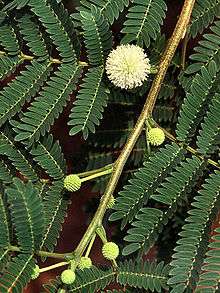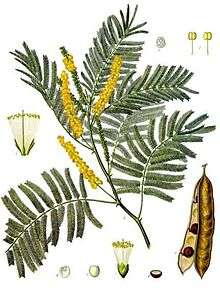Mimosoideae
The Mimosoideae are trees, herbs, lianas, and shrubs that mostly grow in tropical and subtropical climates. They comprise a clade, previously placed at the subfamily or family level in the flowering plant family Fabaceae (Leguminosae). In previous classifications (e.g. the Cronquist system), Mimosoideae refers to what was formerly considered the tribe Mimoseae. Characteristics include flowers in radial symmetry with petals that are valvate (twice divided) in bud, and have numerous showy, prominent stamens. Mimosoideae comprise about 40 genera and 2,500 species.
| Mimosoideae | |
|---|---|
| Calliandra emarginata | |
| Scientific classification | |
| Kingdom: | Plantae |
| Clade: | Tracheophytes |
| Clade: | Angiosperms |
| Clade: | Eudicots |
| Clade: | Rosids |
| Order: | Fabales |
| Family: | Fabaceae |
| Subfamily: | Caesalpinioideae |
| Clade: | Mimosoideae DC. |
| Informal groups | |
|
See text | |
 | |
| Distribution of the Mimosoideae | |
| Synonyms | |
| |
Taxonomy
Some classification systems, for example the Cronquist system, treat the Fabaceae in a narrow sense, raising the Mimisoideae to the rank of family as Mimosaceae. The Angiosperm Phylogeny Group treats Fabaceae in the broad sense. The Mimosoideae were historically subdivided into four tribes (Acacieae, Ingeae, Mimoseae, and Mimozygantheae). However, modern molecular phylogenetics has shown that these groupings were artificial. Several informal subgroups have been proposed, but not yet described formally as tribes.[1][2][3][4][5][6] Additionally, the genus Acacia was recently segregated into five genera (Acacia sensu stricto, Acaciella, Mariosousa, Senegalia, and Vachellia).[7][8]
Basal Mimosoideae
- Adenanthera group[9]
- Adenanthera L.
- Amblygonocarpus Harms
- Calpocalyx Harms
- Pseudoprosopis Harms
- Tetrapleura Benth.
- Xylia Benth.
- Entada group[9]
- Elephantorrhiza Benth.
- Entada Adans.
- Piptadeniastrum Brenan
- Newtonia group
- Fillaeopsis Harms
- Indopiptadenia Brenan
- Lemurodendron Villiers & P. Guinet
- Newtonia Baill.
- Prosopis group
- Prosopis L.
- Xerocladia Harv.
- Mimozyganthus group[10]
- Mimozyganthus Burkart
- Piptadeniopsis Burkart
- Prosopidastrum Burkart
- Leucaena group[4][10]
- Desmanthus Willd.
- Kanaloa Lorence & K.R.Wood
- Leucaena Benth.
- Schleinitzia Warb. ex Nevling & Niezgoda
- Dichrostachys group[4][5][10]
- Alantsilodendron Villiers
- Calliandropsis H.M.Hern. & P.Guinet
- Dichrostachys (DC.) Wight & Arn.
- Gagnebina Neck. ex DC.
- Unassigned
- Aubrevillea Pellegr.
- Chidlowia Hoyle
- Cylicodiscus Harms
- Neptunia Lour
- Pentaclethra Benth.
- Plathymenia Benth.
Acacia clade

- Parkia group
- Anadenanthera Speg.
- Parkia R.Br.
- Piptadenia group[5][11][12]
- Adenopodia C.Presl
- Microlobius C.Presl
- Mimosa L.[13]
- Parapiptadenia Brenan
- Piptadenia Benth.
- Pityrocarpa Britton & Rose
- Pseudopiptadenia Rauschert
- Stryphnodendron Mart.
- Abarema group[14][15][16]
- Abarema Pittier
- Balizia Barneby & J.W.Grimes
- Hydrochorea Barneby & J.W.Grimes
- Ingeae grade (Paraphyletic)
- Acaciella Britton & Rose[17]
- Afrocalliandra E.R. Souza & L.P. Queiroz
- Albizia Durazz.
- Archidendron F.Muell.
- Archidendropsis I.C.Nielsen
- Blanchetiodendron Barneby & J.W.Grimes
- Calliandra Benth.
- Cathormion (Benth.) Hassk.
- Cedrelinga Ducke
- Chloroleucon (Benth.) Britton & Rose
- Cojoba Britton & Rose
- Enterolobium Mart.
- Faidherbia A.Chev.
- Falcataria (I.C.Nielsen) Barneby & J.W.Grimes[18]
- Hesperalbizia Barneby & J.W.Grimes
- Inga Mill.
- Leucochloron Barneby & J.W.Grimes
- Lysiloma Benth.
- Macrosamanea Britton & Rose
- Pararchidendron I.C.Nielsen
- Pseudosamanea Harms
- Sanjappa E.R. Souza & Krishnaraj[19]
- Samanea (Benth.) Merr.
- Serianthes Benth.
- Thailentadopsis Kosterm.
- Viguieranthus Villiers
- Wallaceodendron Koord.
- Zapoteca H.M.Hern.
- Zygia P.Browne
- Pithecellobium group[15][16]
- Ebenopsis Britton & Rose
- Havardia Small
- Painteria Britton & Rose
- Pithecellobium Mart.
- Sphinga Barneby & J.W.Grimes
- Unassigned
- Acacia Mill.
- Mariosousa Seigler & Ebinger
- Paraserianthes I.C.Nielsen
- Parasenegalia Seigler & Ebinger
- Pseudosenegalia Seigler & Ebinger
- Senegalia Raf.
- Vachellia Wight & Arn.
Fossils
The following fossil wood morphogenera have been described:[20][21]
- †Acacioxylon Schenk 1883
- †Adenantheroxylon Prakash & Tripathi 1968
- †Albizinium Prakash 1975
- †Albizzioxylon Nikitin 1935
- †Anadenantheroxylon Brea et al. 2001
- †Cathormion Gros 1990
- †Dichrostachyoxylon Müller-Stoll & Mädel 1967
- †Eucacioxylon Müller-Stoll & Mädel 1967
- †Ingoxylon Müller-Stoll & Mädel 1967
- †Menendoxylon Lutz 1979
- †Metacacioxylon Gros 1981
- †Microlobiusxylon Franco & Brea 2010
- †Mimosoxylon Müller-Stoll & Mädel 1967
- †Mimosaceoxylon Lakhanpal & Prakash1970
- †Paraalbizioxylon Gros 1992
- †Paracacioxylon Müller-Stoll & Mädel 1967
- †Piptadenioxylon Suguio & Mussa 1978
- †Prosopisinoxylon Martínez
- †Tetrapleuroxylon Müller-Stoll & Mädel 1967
Systematics
Modern molecular phylogenetics suggests the following relationships:[22][23][24][25][26][27][28][17]
| ||||||||||||||||||||||||||||||||||||||||||||||||||||||||||||||||||||||||||||||||||||||||||||||||||||||||||||||||||||||||||||
Acacieae
Acacieae (Dumort., 1829[29]) is a wide-ranging, polyphyletic tribe of legumes in the Mimosoideae[30] that is native to the tropics, subtropics, and warm-temperate regions. It includes five or six genera and some 1,450 species.
- Subdivision – 5 or 6 genera
- Acacia Mill. – type genus[30]
- Vachellia Wight & Arn.
- Senegalia Rafinesque
- Acaciella Britton & Rose
- Mariosousa Seigler & Ebinger
- Racosperma Martius
Relationships
In Bentham's 1842 circumscription of the subfamily Mimosoideae, Acacieae was one of its three constituent tribes, the others being Ingeae Benth. & Hook.f. and Mimoseae Bornn.[31] His Acacieae tribe of 1842 included many genera that were subsequently assigned to tribe Ingeae Benth. In 1875, however, Bentham narrowed his definition of Acacieae so as to include only Acacia Mill.[32]
The only morphological character of Acacieae used to distinguish it from the Ingeae is the presence of free stamens (as in tribe Mimoseae).[31] In the Ingeae they are fused in the form of a tube, whereas in the Acacieae only a few species have the stamens fused at the base. Several characters of the foliage, seeds, seed pods, pollen, and stipules are shared by the two tribes.[31] The flower morphology of Acacia s.l. has characteristics in common with the genera Leucaena, Piptadenia, and Mimosa (tribe Mimoseae) and Enterolobium and Lysiloma (tribe Ingeae).[33]
The tribal position of monotypic genus Faidherbia A. Chevalier is equivocal.[30] It was included in the Acacieae by Vassal (1981) and Maslin et al. (2003), but Lewis & Rico Arce placed it in tribe Ingeae following Polhill (1994) and Luckow et al. (2003).[30][34] In the latter case, tribe Acacieae may conform to genus Acacia s.l., pending the latter's relationship to other mimosoid genera. Faidherbia is troublesome as its stamens are shortly united at their base and its pollen is similar to some taxa in the Ingeae.[32]
Description
They are trees, shrubs or lianas, which may be armed or unarmed.[35] Where they have spines, these are modified stipules. In some, prickles arise from the stem's cortex and epidermis.[36] The leaves are bipinnate or are modified to vertically oriented phyllodes. A few have cladodes rather than leaves.[37] Extrafloral nectaries may be present on the petiole and rachis, and the pinnule tips may carry protein-lipid Beltian bodies.[36] The leaflets are usually opposite, and are carried on shortly stalks or are sessile. The heartwood is typically red and hard,[38] and the sap of various species hardens into gum.[37]
The inflorescences are dense pedunculate heads or spikes borne in axillary clusters, or are aggregated in terminal panicles.[35] The tetra- or pentamerous flowers are uniformly bisexual, or male and bisexual. Sepals are connate (i.e. fused) and valvate (i.e. not overlapping). The reduced petals are valvate, or rarely absent. The flowers have numerous exserted (i.e. protruding) stamens (>2× as many as the corolla lobes),[33] and their filaments are sometimes connate at their base (forming a short stemonozone). Male flowers of some Neotropical species have a reduced staminal tube (cf. A. albicorticata, A. hindsii, A. farnesiana, and S. picachensis).[33] Flowers are usually yellow or cream-coloured, but may be white, red, or purple.[37]
The ovary is sessile or stipitate (i.e. supported by a stipe), with many ovules or ovules arranged in two rows. The ovary is attached by a filiform style to a small, capitate stigma. The legume's endocarp is attached to the exocarp, but is otherwise very variable, and may be dehiscent or indehiscent. Seeds are usually elliptic to oblong and flattened to varying degrees. Seeds have a hard black-brown testa (i.e. seed coat) with a pleurogram, visible as a closed or almost closed O-shaped line. Some phyllodinous species have a colourful aril or elaiosome on the seed.[35]
References
- Bouchenak-Khelladi Y; Maurin O; Hurter J; van der Bank M (2010). "The evolutionary history and biogeography of Mimosoideae (Leguminosae): An emphasis on African acacias". Molecular Phylogenetics and Evolution. 57 (2): 495–508. doi:10.1016/j.ympev.2010.07.019. PMID 20696261.
- Brown GK (2008). "Systematics of the tribe Ingeae (Leguminosae-Mimosoideae) over the past 25 years" (PDF). Muelleria. 26 (1): 27–42.
- Lewis GP; Elias TS (1981). "Mimoseae". In Polhill RM; Raven PH (eds.). Advances in Legume Systematics, Parts 1 and 2. Royal Botanic Gardens, Kew. pp. 155–168. ISBN 9780855212247.
- Luckow M; White PJ; Bruneau A (2000). "Relationships among the basal genera of mimosoid legumes". In Herendeen PS; Bruneau A; Pollard PS (eds.). Advances in Legume Systematics, Part 9. Royal Botanic Gardens, Kew. pp. 165–180. ISBN 9781842460177.
- Luckow M, Miller JT, Murphy DJ, Livshultz T (2003). "A phylogenetic analysis of the Mimosoideae (Leguminosae) based on chloroplast DNA sequence data" (PDF). In Klitgaard BB, Bruneau A (eds.). Advances in Legume Systematics, Part 10: Higher Level Systematics. Royal Botanic Gardens, Kew. pp. 197–220. ISBN 9781842460542.
- Hughes CE, Bailey CD, Krosnick S, Luckow MA (2003). "Relationships among genera of the informal Dichrostachys and Leucaena groups (Mimosoideae) inferred from ribosomal ITS sequences" (PDF). In Klitgaard BB, Bruneau A (eds.). Advances in Legume Systematics, Part 10: Higher Level Systematics. Royal Botanic Gardens, Kew. pp. 221–238. ISBN 9781842460542.
- Murphy DJ; Brown GK; Miller JT; Ladiges PY (2010). "Molecular phylogeny of Acacia Mill. (Mimosoideae: Leguminosae): Evidence for major clades and informal classification". Taxon. 59 (1): 7–19. doi:10.1002/tax.591002. JSTOR 27757046.
- Kyalangalilwa B; Boatwright JS; Daru BH; Maurin O; van der Bank M (2013). "Phylogenetic position and revised classification of Acacia s.l. (Fabaceae: Mimosoideae) in Africa, including new combinations in Vachellia and Senegalia". Botanical Journal of the Linnean Society. 172 (4): 500–523. doi:10.1111/boj.12047.
- Cury de Barros T; Pádua Teixeira S (2016). "Revisited anatomy of anther glands in mimosoids (Leguminosae)". International Journal of Plant Sciences. 177 (1): 18–33. doi:10.1086/683844.
- Luckow M; Fortunato RH; Sede S; Livshultz T (2005). "The phylogenetic affinities of two mysterious monotypic mimosoids from southern South America". Syst Bot. 30 (3): 585–602. doi:10.1600/0363644054782206.
- Jobson RW; Luckow M (2007). "Phylogenetic study of the genus Piptadenia (Mimosoideae: Leguminosae) using plastid trnL–F and trnK/matK sequence data". Syst Bot. 32 (3): 569–575. doi:10.1600/036364407782250544.
- Simon MF; Pastore JFB; Souza AF; Borges LM; Scalon VR; Ribeiro PG; Santos-Silva J; Souza VC; de Queiroz LP (2016). "Molecular phylogeny of Stryphnodendron (Mimosoideae, Leguminosae) and generic delimitations in the Piptadenia Group". International Journal of Plant Sciences. 177 (1): 44–59. doi:10.1086/684077.
- Simon MF; Grether R; de Queiroz LP; Skema C; Pennington RT; Hughes CE (2009). "Recent assembly of the Cerrado, a neotropical plant diversity hotspot, by in situ evolution of adaptations to fire". Proc Natl Acad Sci USA. 106 (48): 20359–20364. Bibcode:2009PNAS..10620359S. doi:10.1073/pnas.0903410106. PMC 2787167. PMID 19918050.
- Iganci JRV; Soares MV; Guerra E; Morim MP (2016). "A Preliminary Molecular Phylogeny of the Abarema Alliance (Leguminosae) and Implications for Taxonomic Rearrangement". International Journal of Plant Sciences. 177 (1): 34–43. doi:10.1086/684078.
- Brown GK; Murphy DJ; Miller JT; Ladiges PY (2008). "Acacia s.s. and its relationship among tropical legumes, tribe Ingeae (Leguminosae: Mimosoideae)". Syst Bot. 33 (4): 739–751. doi:10.1600/036364408786500136.
- de Souza ER; Lewis GP; Forest F; Schnadelbach AS; van den Berg C; de Queiroz LP (2013). "Phylogeny of Calliandra (Leguminosae: Mimosoideae) based on nuclear and plastid molecular markers". Taxon. 62 (6): 1200–1219. doi:10.12705/626.2.
- Seigler DS, Ebinger JE. (2017). "Parasenegalia and Pseudosenegalia (Fabaceae : Mimosoideae): New genera of the Mimosoideae". Novon. 25 (2): 180–205. doi:10.3417/2015050.CS1 maint: uses authors parameter (link)
- Brown GK; Murphy DJ; Ladiges PY (2011). "Relationships of the Australo-Malesian genus Paraserianthes (Mimosoideae: Leguminosae) identifies the sister group of Acacia sensu stricto and two biogeographical tracks". Cladistics. 27 (4): 380–390. doi:10.1111/j.1096-0031.2011.00349.x.
- de Souza ER; Krishnara MV; de Queiroz LP (2016). "Sanjappa, a new genus in the tribe Ingeae (Leguminosae: Mimosoideae) from India" (PDF). Rheedea. 26 (1): 1–12.
- Franco, María Jimena; Brea, Mariana (2010). "Microlobiusxylon paranaensis gen. et sp. nov. (Fabaceae, Mimosoideae) from the Pliocene-Pleistocene of Ituzaingó Formation, Paraná Basin, Argentina". Revista Brasileira de Paleontologia. 13 (2): 103–114. doi:10.4072/rbp.2010.2.03.
- Martínez, Leandro C.A. (2010). "Prosopisinoxylon anciborae nov. gen. et sp. (Leguminosae, Mimosoideae) from the Late Miocene Chiquimil Formation (Santa María Group), Catamarca, Argentina". Review of Palaeobotany and Palynology. 158 (3–4): 262–271. doi:10.1016/j.revpalbo.2009.09.006.
- Bruneau A; Forest F; Herendeen PS; Klitgaard BB; Lewis GP (2001). "Phylogenetic Relationships in the Caesalpinioideae (Leguminosae) as Inferred from Chloroplast trnL Intron Sequences". Syst Bot. 26 (3): 487–514. doi:10.1043/0363-6445-26.3.487 (inactive 2020-03-12).
- Miller JT; Grimes JW; Murphy DJ; Bayer RJ; Ladiges PY (2003). "A phylogenetic analysis of the Acacieae and Ingeae (Mimosoideae: Fabaceae) based on trnK, matK, psbA–trnH, and trnL/trnF sequence data". Syst Bot. 28 (3): 558–566. doi:10.1043/02-48.1 (inactive 2020-03-12). JSTOR 25063895.
- Bruneau A; Mercure M; Lewis GP; Herendeen PS (2008). "Phylogenetic patterns and diversification in the caesalpinioid legumes". Botany. 86 (7): 697–718. doi:10.1139/B08-058.
- Miller JT; Murphy DJ; Brown GK; Richardson DM; González-Orozco CE (2011). "The evolution and phylogenetic placement of invasive Australian Acacia species". Diversity and Distributions. 17 (5): 848–860. doi:10.1111/j.1472-4642.2011.00780.x.
- Manzanilla V; Bruneau A (2012). "Phylogeny reconstruction in the Caesalpinieae grade (Leguminosae) based on duplicated copies of the sucrose synthase gene and plastid markers". Molecular Phylogenetics and Evolution. 65 (1): 149–162. doi:10.1016/j.ympev.2012.05.035. PMID 22699157.
- LPWG [Legume Phylogeny Working Group] (2013). "Legume phylogeny and classification in the 21st century: Progress, prospects and lessons for other species-rich clades" (PDF). Taxon. 62 (2): 217–248. doi:10.12705/622.8. hdl:10566/3455.
- Miller JT; Seigler D; Mishler BD (2014). "A phylogenetic solution to the Acacia problem". Taxon. 63 (3): 653–658. doi:10.12705/633.2.
- "Taxon: Tribe Acacieae Dumort. (1829) (plant)". The Taxonomicon. Retrieved 19 November 2015.
- Lewis, G.P. "Acacieae Dumort 1829". Kew. Archived from the original on 6 September 2015. Retrieved 19 November 2015.
- Shinwari, Zabta K.; Jamil, Khansa; Zahra, Nadia Batool (2014). "Molecular systematics of selected genera of subfamily Mimosoideae-Fabaceae" (PDF). Pak. J. Bot. 46 (2): 591–598. Retrieved 23 November 2015.
- Miller, Joseph T.; Bayer, Randall J. (April 2001). "Molecular phylogenetics of Acacia (Fabaceae: Mimosoideae) based on the chloroplast MATK coding sequence and flanking TRNK intron spacer regions". Am. J. Bot. 88 (4): 697–705. doi:10.2307/2657071. JSTOR 2657071. PMID 11302857. Retrieved 23 November 2015.
- Rico Arce, M. de L.; Bachman, S. (2006-12-30). "A taxonomic revision of Acaciella (Leguminosae, Mimosoideae)". Anales del Jardín Botánico de Madrid. 63 (2): 189–244. doi:10.3989/ajbm.2006.v63.i2.7. Retrieved 20 November 2015.
- "Taxon: Genus Faidherbia A. Chevalier, 1934 (plant)". The Taxonomicon. Retrieved 19 November 2015.
- 吴德邻, Wu Delin; Nielsen, Ivan C. (2009). "Flora of China, 6. Tribe ACACIEAE" (PDF). Missouri Botanical Garden Press. Retrieved 19 November 2015.
- Armstrong, W. P. "Botany 115 Vegetative Terminology, Modified Roots, Stems and Leaves". Waynes Word. Retrieved 19 November 2015.
- "Acacia, Thorntree". EOL. Retrieved 22 November 2015.
- Nicholson, Paul T. (editor); Shaw, Ian (2000). Ancient Egyptian materials and technology (1. publ., repr. ed.). Cambridge: Cambridge Univ. Press. p. 335. ISBN 9780521452571.CS1 maint: extra text: authors list (link)
External links


